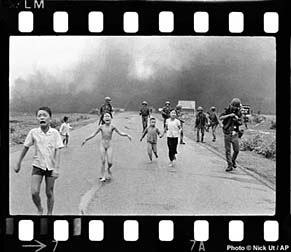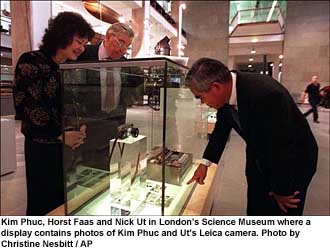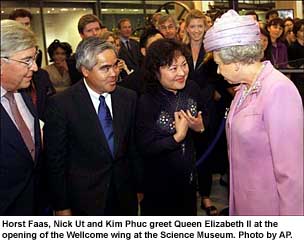|
Photographer who saved her are Honored by the London Science Museum and Queen Elizabeth II. By Horst Faas and Marianne Fulton
The girl was Phan Thi Kim Phuc. The photograph showing excruciating pain and death has become a photographic icon, an antiwar rallying point and a symbol of hope. The photograph rightly stands among a few honorable and memorable images of the last 150 years of photojournalism. The article and photographs show, for the first time, the well known image among the others taken before and after the incident. We will hear from the participants of the time - Kim Phuc, Nick Ut and others in interviews gathered by Horst Faas. The occasion which brought the participants together was the opening of the large exhibition at the London Science Museum, "Making the Modern World", part of the new Wellcome Center. The large display was organized by senior curator Andrew Nahum and officially opened by Queen Elizabeth II.
"More than just showing the iconic image, we went to unpack the history around it," Nahum said. So the exhibition identifies other children in the photo, including Kim's older brother who lost an eye, but survived to live until this day in Trang Bang. There are also pictures of the two children related to Kim Phuc who died shortly after the incident from napalm inflicted burns. The picture taken near the village of Trang Bang in South Vietnam on June 8, 1972, thrust the burned, screaming youngster into photographic history. The London "Observer" Sunday paper calls the photograph "the most haunting image of the horror of war since Goya" in their review of the exhibit (by science writer Deyan Sudjic). Next to Ut's Leica M2 camera, manufactured in 1965, and the 35mm Summicron lens stands one of the Muirhead picture transmitters used to transmit photographs on radio-waves to the world from the Vietnam conflict. The camera is shown in a case not far from the German V2 rocket of 1945 and Stephenson's Rocket of 1829. Stretched over four floors, the new 50 million Pounds Sterling ($75 million) Wellcome Wing of the London Science Museum presents the new exhibition (since June 27, 2000) with a vast display of technology's iconic images and inventions from the past 200 years. There are also displays on genetics, digital technology, bio-medicine and artificial intelligence linking history with current developments.
Queen Elizabeth II meets Kim Phuc and Nick Ut
"Is that really you?" the Queen said, when she saw the now 37-year old Phan Thi Kim Phuc standing next to her picture from 1972, clad in a black silk traditional Vietnamese Ao Dai tunic and trousers. Beside Kim stood photographer Nick Ut and Horst Faas, AP's Saigon photo editor in 1972, who had selected and transmitted the photograph. Behind Kim stood her husband Bui Huy Toan. The two women chatted for several minutes. Stefan Klein, London correspondent of the renowned Sueddeutsche Zeitung wrote of the meeting: "She has suffered a lot and sometimes Kim Phuc thought she won't manage to live on. However, now she stood there, a smiling Asian woman, deep in conversation with the British Queen, who may have wondered how during the journey of a lifetime a bridge can be built from horror and dread to peace and forgiving, all personified in one human being". Klein continues: " The photographer was also a human being: It was he who poured water over the wounds of the burned girl and he drove her to a hospital where her life was saved." Kim Phuc, now a United Nations goodwill ambassador working for world peace. Kim Phuc was asked by the Queen about the picture and her life today. Kim said: "I told her it seemed a long time ago."
The Impact of the
Kim Phuc Picture Martin Woolacott, a former Vietnam correspondent wrote about a display of the exhibition's photographs in the London Daily Telegraph (27 June 2000): "Nick Ut's photograph had an extraordinary impact around the world. The psychological history of the war seems inconceivable without this image. Along with half a dozen other photographs, it helped at some deep level to shape the popular feelings which in turn influenced policy it deepened the skepticism with which by the mid-1972, the war was being viewed. " Woolacott added: "The image was so powerful that it was immediately appropriated by the Vietnamese communists for propaganda use." In the International Herald Tribune, from Thursday June 29, 2000, Tom Buerkle wrote, "The picture.. For anyone old enough to remember the Vietnam War the photograph of the naked 9-year-old girl running toward a camera screaming in agony as napalm burned her flesh is seared into the consciousness. " "Her image has become a symbol of war that transcends debate about the rights or wrongs of U.S. intervention in Vietnam." |
 On
June 8, 1972, children and their families fled the village of Trang
Bang down Route-1, their bodies seared by napalm. The young girl
screaming, in particular, was etched onto the world's mind by the
photograph of Huynh Cong 'Nick' Ut, an AP photographer.
On
June 8, 1972, children and their families fled the village of Trang
Bang down Route-1, their bodies seared by napalm. The young girl
screaming, in particular, was etched onto the world's mind by the
photograph of Huynh Cong 'Nick' Ut, an AP photographer.
 In
preparing the exhibit, senior curator Andrew Nahum said he looked
at many famous photographs "but I couldn't persuade myself that
any of them had the emotional power of the Kim Phuc photo."
In
preparing the exhibit, senior curator Andrew Nahum said he looked
at many famous photographs "but I couldn't persuade myself that
any of them had the emotional power of the Kim Phuc photo."
 Queen
Elizabeth II toured London Science Museum before officially opening
the Wellcome Wing and the exhibit "Making the Modern World".
Queen
Elizabeth II toured London Science Museum before officially opening
the Wellcome Wing and the exhibit "Making the Modern World".